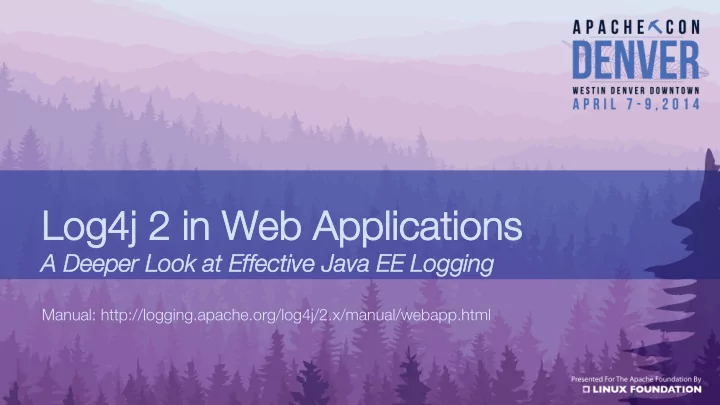

� Log4j 2 in Web Applications Log4j 2 in Web Applications � A Deeper Look at Effective Java EE Logging A Deeper Look at Effective Java EE Logging � Manual: http://logging.apache.org/log4j/2.x/manual/webapp.html
Nick Williams – Introduction Nick Williams – Introduction • Software Engineer @ UL Workplace Health & Safety • Committer & PMC Member @ Apache Logging • Committer @ FasterXML Jackson Mapper Datatype JSR 310 • Author of Professional Java for Web Applications � (Wiley, 2014, http://amzn.to/1bSSz6T) • GitHub @beamerblvd / Twitter @Java_Nick
Why is web app logging dif Why is web app logging differ ferent? ent? Multithreading is crucial to web application operation • Web applications handle thousands of simultaneous • users Web containers can host multiple applications • simultaneously Web containers often provide their own logging facilities • Logging initialization and shutdown is more complex •
Log4j 2 + Java EE = Easy Log4j 2 + Java EE = Easy Register filter and listener for Java EE 5 (Servlet 2.5) • Log4j auto-initializes in Java EE 6 and Java EE 7 • (Servlet 3.0, 3.1) Customize logging configuration location using context • parameters Creating a filter to fish tag requests • Dealing with asynchronous request handling • Logging in JavaServer Pages with the JSP tag library •
Java EE 5 Configuration Java EE 5 Configuration Log4j 2 does not support Java EE 4 / Servlet • 2.4 and older web applications What makes a web application Java EE 5 / • Servlet 2.5? Registering the Log4jServletContextListener • Registering the Log4jServletFilter •
Java EE 6+ Configuration Java EE 6+ Configuration Log4j 2 “just works” in Java EE 6 / Servlet 3.0 and • newer web applications Be careful with older Tomcat 7 installations • Understanding the Log4jServletContainerInitializer • Disabling “just works” with • isLog4jAutoInitializationDisabled Manually registering the filter and listener could result in • errors
Config Context Parameters Config Context Parameters Setting the logging context name with • log4jContextName Setting the configuration file with • log4jConfiguration Using the JNDIContextSelector •
Fish T Fish Tagging W agging Web Requests eb Requests What is a fish tag? • Using the ThreadContext • Creating a fish-tagging filter •
Asynchr Asynchronous Requests onous Requests A crash course on Servlet 3.0+ asynchronous • requests Understanding how thread unpredictability • makes logging difficult Handling asynchronous requests and logging • properly Configuring filters properly •
Using the JSP T Using the JSP Tag Library ag Library Reminder: Upgrade Tomcat 7 • Why logging in JavaServer Pages should be • avoided When it can’t be avoided, the JSP tag library • makes logging in JSPs simple
Questions? I’ll be signing and selling copies of my book in the Confluence Foyer today 12:20 to 2:30 and 3:45 to 6:30, tomorrow 10:00 to 1:15 and 2:15 to 3:15, and off and on Thursday and Friday. (http://amzn.to/1bSSz6T)
Recommend
More recommend